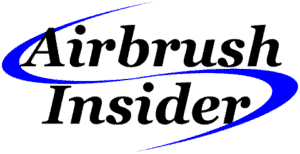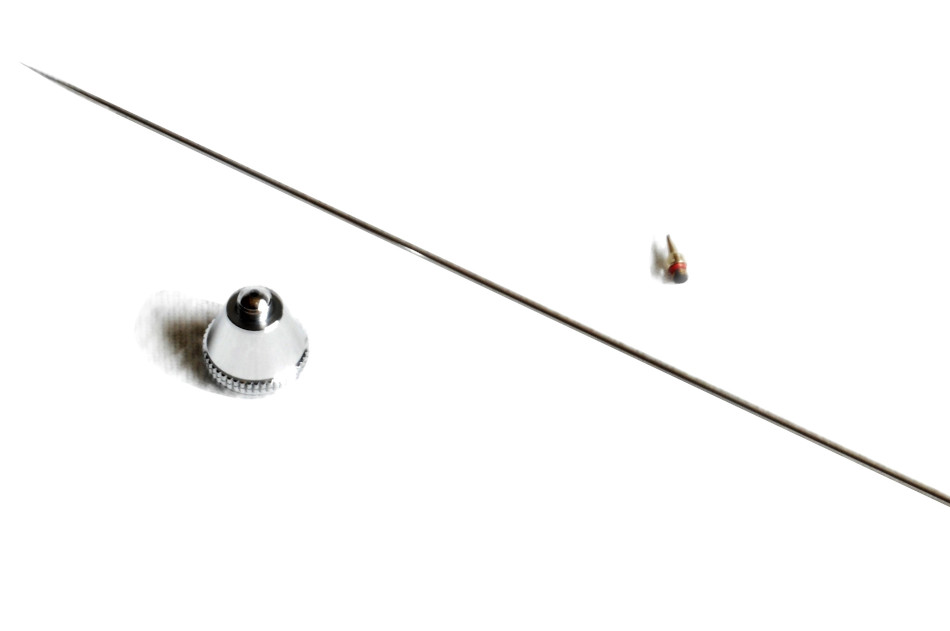It is very common for airbrush needles and nozzles to get damaged, and when they do, It can be difficult finding exact replacement parts in a timely manor. This begs the question: “Are needles and nozzles universal, or interchangeable between different airbrush models, and manufacturers?
Assuming the sizing of the replacement parts match the components in the airbrush, that is.
Well today we are going to dive deep in to this question. My goal here is to hit on all aspects when it comes to needles and nozzles and what can come from swapping / interchanging these parts from one airbrush model to another…
Because you would think there wouldn’t be much of a difference in these parts from one airbrush to the other. Especially given how susceptible the nozzle and needle is to damage.
But trust me, there is a difference…
Before we dive in, lets briefly discuss airbrush needle and nozzle sizing so that you fully understand the sizing aspects of a needle an nozzle, then we will discuss just how versatile these parts are.
Needle & Nozzle Sizing Aspects To Consider
Airbrush needles and nozzles are basically meant to be mated with one another.
This means the exterior tip of the needle must be sized & tapered precisely to seat inside the nozzle, and vice versa (The Interior of the nozzle sized & tapered exactly to seat flush with the exterior tip of the needle).
Think of the needle like a mechanical cork, and the nozzle is the bottle neck. The needle needs to fit precisely into the nozzle in order to plug the flow of paint. Otherwise the airbrush will allow paint through the nozzle when you don’t want it to…
So, what does this mean?
This means you must get a needle that is sized the same as the nozzle or vice versa (A nozzle that is sized for the needle).
If you try to pair a nozzle (Example: 0.3mm Nozzle) with too large of needle (Example: 0.5mm Needle) you wont have a complete seal when you go to stop the paint flow, and paint will continue to flow.
The opposite is also true,
If you try to pair a needle with too large of nozzle, again, you won’t have a complete seal and paint will leak when you don’t want it to… Resulting in imperfections in your artwork that will require fixing.
Basically speaking, the size of the nozzle (Example: 0.3mm) must match the needle (Example 0.3mm).
Anyway, lets discuss the compatibility possibilities, as well as the possible issues to occur when using different needles and/ or nozzles with your airbrush then are specifically designed to be.
Airbrush Needle & Nozzle Compatibility
Now that you know basic sizing for needles and nozzles. The question now is can you take a needle or nozzle from a different airbrush / designed for a different airbrush, and use it in your airbrush?
For example, can you take a 0.35mm needle designed for a Badger airbrush and place it in an Iwata airbrush with a 0.35mm nozzle? (Swapping components across manufacturers)
On that same note,
Can you take, say, a 0.35mm needle designed for an Iwata Eclipse airbrush, and use it in an Iwata Neo airbrush with a 0.35mm nozzle??? (Swapping components across models within the same brand)
Theoretically this should work in both instances, given the sizing of both the needle and nozzle matches (0.35mm), But will the other dimensions of these components match?
Needle & Nozzle Compatibility Between Different Manufacturers
Its kinda common sense to assume different manufacturers have similar but different products. Especially when it comes to airbrushes. I mean, they each clearly have their own style when it comes to the design of their products.
For instance, you can clearly tell the difference between an airbrush made by Iwata & and airbrush made by Badger, Harder & Steinbeck, Paasche and so forth. Just the overall structural design is different both visually and mechanically.
But are the internal parts much different from one another, such as the needle and nozzle?
Needle Compatibility Between Different Manufacturers
Simply put, needles are machined to fit the specific model of airbrush it was intended for. Trying to interchange a needle across different manufacturers is not likely to work. At least in any reliable sense.
However, that being said, your odds of a needle from a different manufacturer fitting your airbrush (Assuming the size of the needle matches what came out of the airbrush) are greater then a nozzle of a different manufacturer fitting your airbrush. Simply because each company utilizes a different method for attaching the nozzle to the airbrush body.
However, the needles are closer in relation to one another. But under most circumstances not related enough…
Nozzle Compatibility Between Different Manufacturers
Nozzles are specifically machined to attach to the airbrush body they were intended for. Nozzles are commonly either threaded, or bored in a manner that directly fits the airbrush body of that specific airbrush.
Now, trying to take a nozzle from a different airbrush manufacturer and mate it to the body of your airbrush is most-likely, if not certainly not going to work. Especially if your using a higher end airbrush such as an Iwata, Badger, Paasche, Harder & Steinbeck and so forth…
Nozzle’s have to be precisely machined to fit the airbrush body, as well as the nozzle cap, and the needle that will operate inside it. To find another brands nozzle that fits all 3 of these criteria to the precise degree is very unlikely…
Needle & Nozzle Compatibility Between Different Models
In a relative sense, you’d think that an airbrush that is from the same manufacturer would have universal components between the different airbrushes they sell, Right?
Well, this isn’t always the case…
I decided to reached out to Iwata (One of the largest airbrush manufacturers in the industry) about the possibility of swapping needles and nozzles between their airbrush lines, and they had this to say:
“Unfortunately the needles and nozzles are not interchangeable between lines. Each nozzle and needle is specifically designed for each line and engineered to offer different benefits in each line.”
Anest Iwata-Medea
Needle Compatibility Between Different Airbrush Models (Same Manufacturer)
Though it makes sense from a simplicity stand point. I mean, why wouldn’t those who manufacture airbrushes utilize the same needle dimensions other then thickness (To vary spray thickness)?
But after some analysis, as well as Iwata’s input, I have come to the conclusion that its not only the thickness of the needle that changes from one model airbrush needle to the other.
It is also the Length of the needle from tip to tail, and The taper of the needle tip (some taper more aggressively then others).
These measurements of the needle vary even between airbrush models within a specified brand, so even though your odds are greater when trying to exchange needles across lines, your odds of everything working out right are still quite low.
For example, I have an Iwata Neo airbrush. To which I needed a new needle for a while back. While I was at my local Hobby Lobby, I went to pick up a needle. However, they didn’t have one for the Neo at the moment. They only had one for an Iwata Eclipse.
The diameter of the needle was the same as what I needed (0.35mm) but after closer inspection I noticed the length of the needle for the Eclipse was 5 1/2″ where as the needle for the Neo is 5 5/16″.
So clearly the needle designed for the Eclipse wouldn’t have fit the Neo given it is too long, Now I’m sure if I was to precisely measure and compare both the needle for the Neo, and the needle for the Eclipse, odds are there would be more of a difference then simply the length of the needle…
Nozzle Compatibility Between Different Airbrush Models (Same Manufacturer)
Like stated above, Nozzles are specifically machined to fit the airbrush they were intended for. Granted airbrushes within the same model line have a greater chance of utilizing the same components then that of complete opposite manufacturers.
Though there can be very subtle differences from one model to the other that don’t allow the components to mate properly…
Lets talk the dimensions of both the needle and nozzle to consider when interchanging components that are designed for different airbrushes.
Needle Dimensions To Consider
The following dimensions of an airbrush needle need to match precisely to the needle pulled out of your airbrush in order for it to operate semi-correctly with your airbrush.
- The Diameter of the needle body
- The length of the needle body
- The Taper or Cant of the needle tip
- The length of the overall needle
Nozzle Dimensions To Consider
The following dimensions of an off brand airbrush nozzle need to match the nozzle pulled from your airbrush precisely in order to function semi-correctly..
- The mating Surface (where the nozzle connects to the body of the airbrush)
- The Thread Depth / Bore Depth of the nozzle
- The Outer Diameter of the nozzle
- The Inner Diameter of the nozzle
- The outer Taper of the nozzle
- The Inner Taper of the nozzle
- And likely a few other dimensions that are specialty nozzle specific.
As you can see, there is more dimensions to be considered when it comes to the nozzle of an airbrush. For this reason, it is not likely to find a nozzle that will fit your specific airbrush outside of the nozzle that is specifically designed for it.
Conclusion
The closest you will likely come to finding a needle and nozzle that fits your airbrush (Aside from the one that is manufactured specifically for your airbrush) is by using one that is within the same model line. At least when it comes to using a branded airbrush such as an, Iwata, Badger, Paasche and so forth…
However, that being said. a lot needs to line up dimensional when using unrelated, or semi-related parts in order for the airbrush to operate in a proper manor…
My recommendation when it comes to trying to use alternative parts / components with your airbrush, is to not to. Use only the needle, nozzle and so forth that was specifically designed for your airbrush. Don’t try to use another models parts, this will likely just lead to more headache and potential damage to your airbrush.
I mean, your odds of finding another needle or nozzle that fits your airbrush isn’t impossible. Its just not likely, at least for the majority of airbrushes out there…
Now if your in a time crunch and you need to finish a project, and your willing to take a risk, then it may be more worth while giving alternative components a try, assuming the part/s clearly matches the removed one/s. But still your run a risk of damaging your airbrush, and you run an even higher risk of the airbrush not responding correctly with the alternative components, likely causing trouble to your artwork.
Anyway, I hope you were able to find some value here! If you have any further questions regarding the airbrush do be sure to take a look around the website. Airbrush Insider is dedicated to helping all in the airbrush community!
This is Colt signing off!
Check Out Some Of My Favorite Airbrush Equipment:

